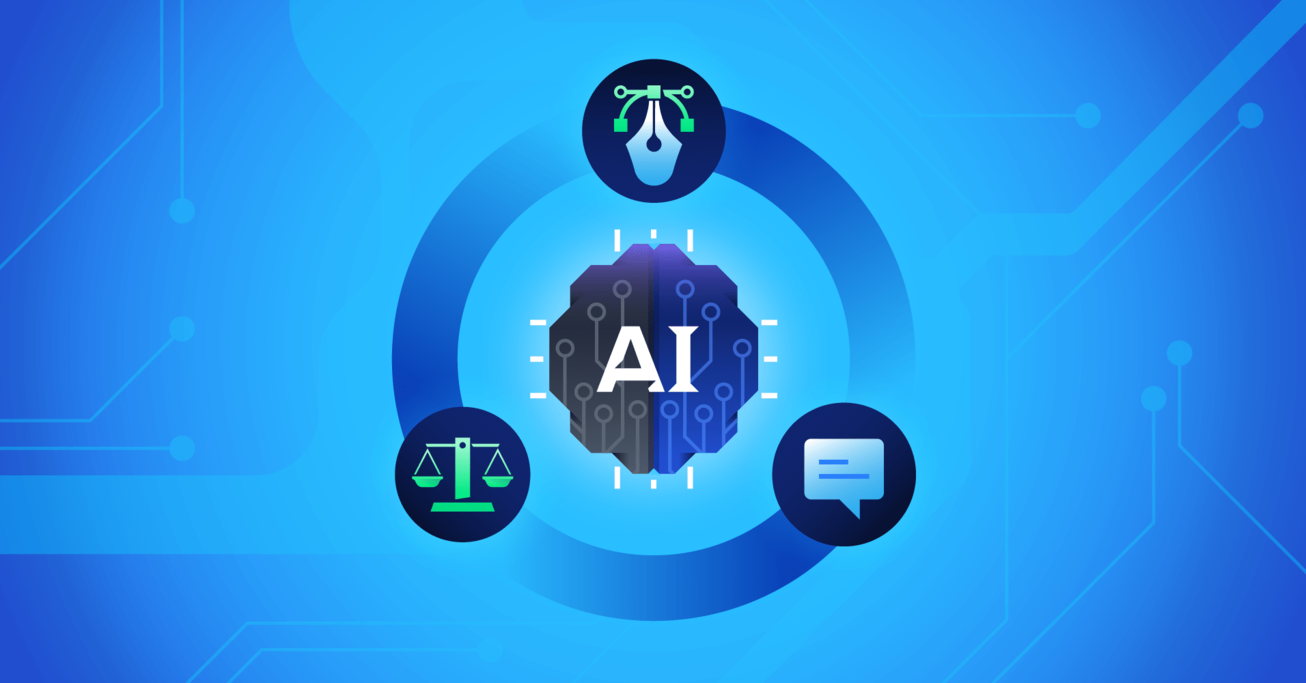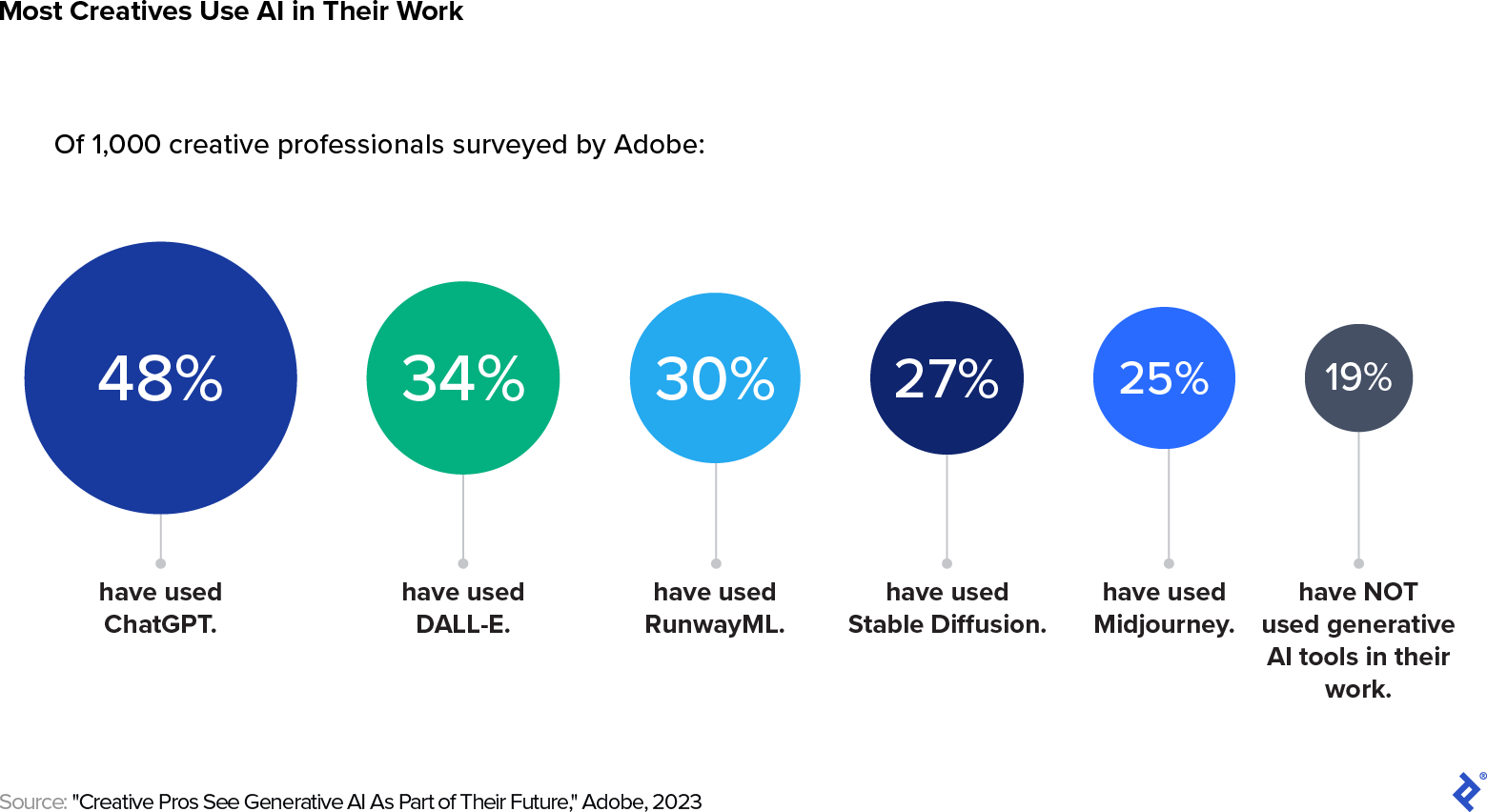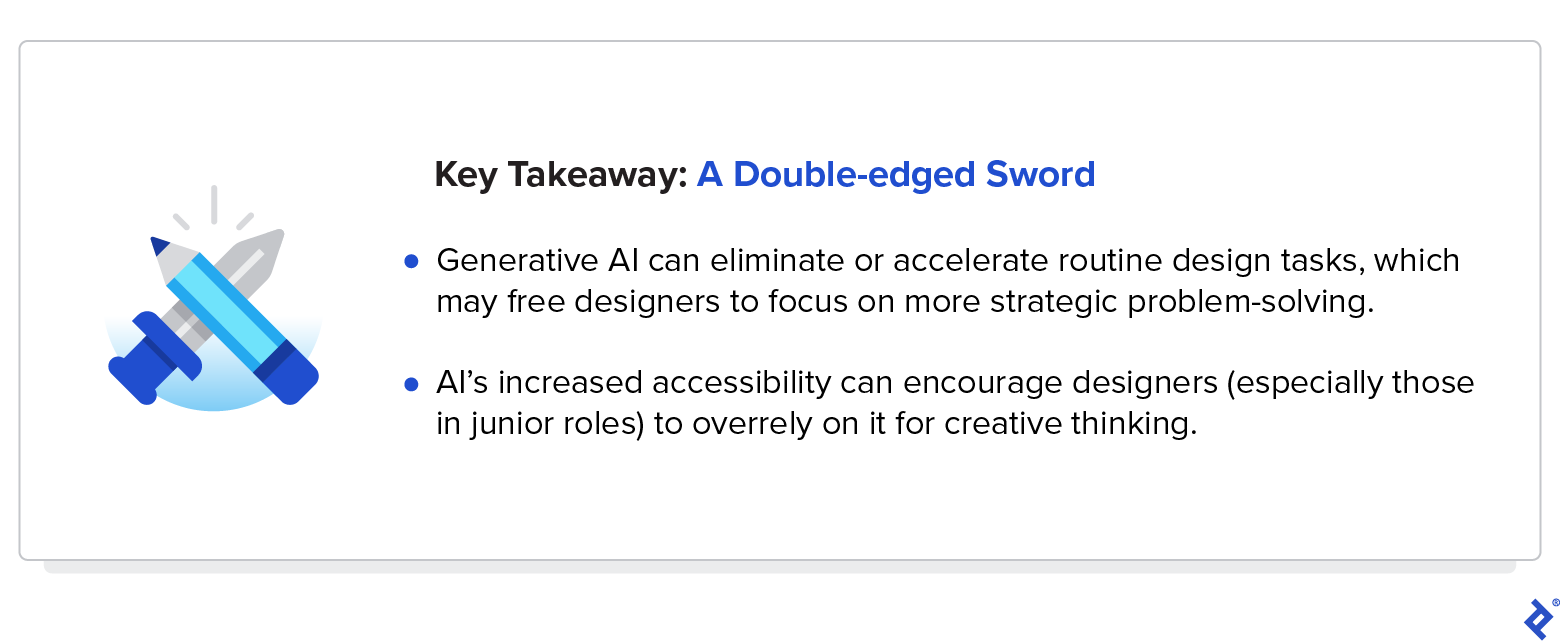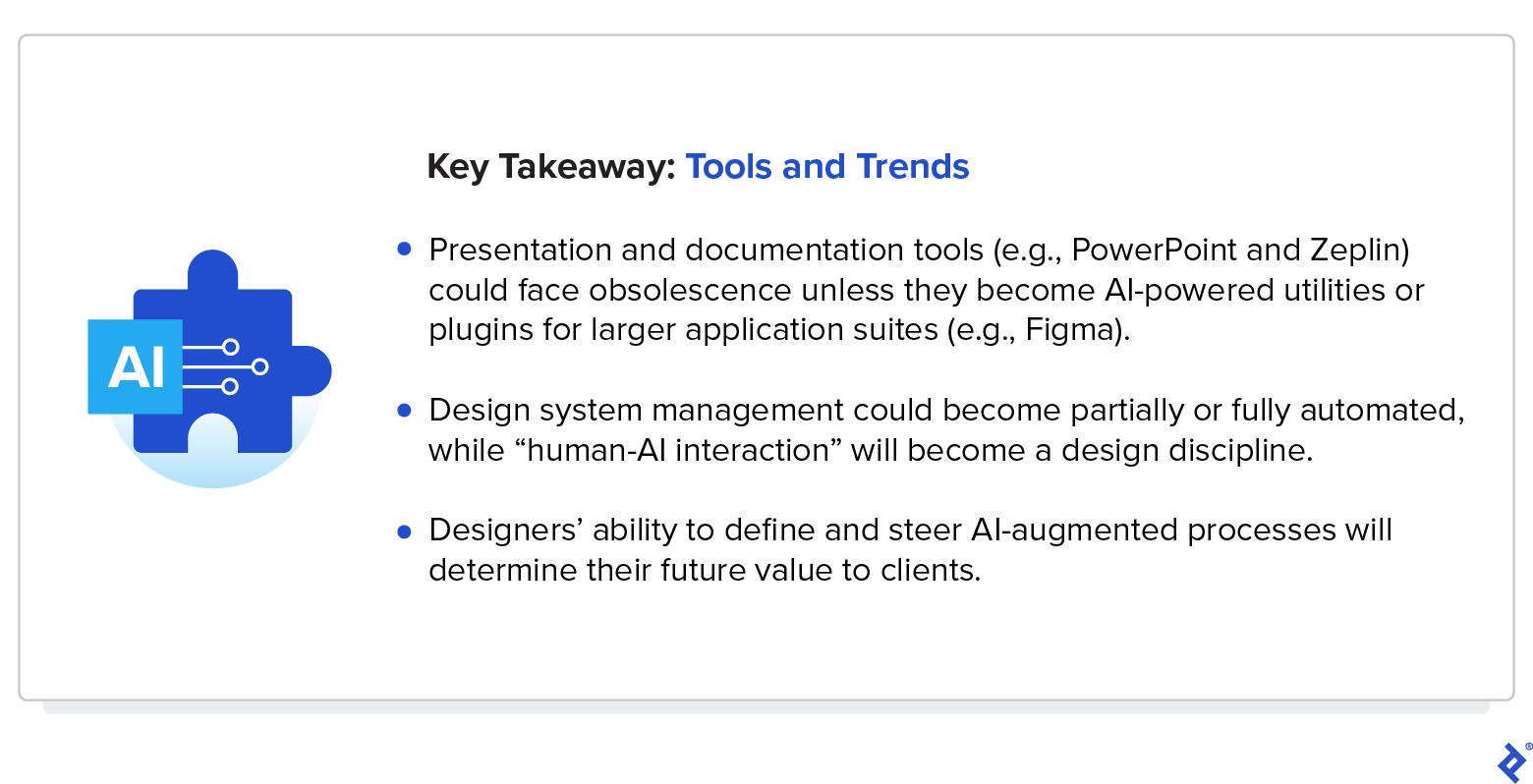AI in Design: Experts Discuss Practical Applications, Ethics, and What’s Coming Next
In this wide-ranging Q&A, two Toptal designers delve into the influence of generative AI on design and its implications for creative thinking, user research, and entry-level designers.
In this wide-ranging Q&A, two Toptal designers delve into the influence of generative AI on design and its implications for creative thinking, user research, and entry-level designers.
Authors
Darrell is a UX designer with more than 25 years of experience designing highly complex apps for companies such as IBM, CSX, and CarMax. His redesign for the IBM Maximo mobile app won the 2021 Gold Spark Design Award for product design.
Previous Role
Design LeadPREVIOUSLY AT


Gytis is a digital product designer with more than eight years of experience designing for companies such as Shell, Ford, BP, and Tailwind. He applies a scientific approach that diligently tests designs to produce user-friendly products.
Previous Role
Web DesignerPREVIOUSLY AT


Generative AI isn’t coming for design: It’s already here. Apps like Gamma and Notion use AI to “write” presentations and documentation. Adobe Firefly can conjure up Photoshop compositions from just a few prompts. A controversial startup is even touting its ability to deliver “user research without the users”—all thanks to generative AI.
This sudden surge in capability puts professional designers in a complicated position. As more companies rush to integrate AI features into their products, designers will be needed to craft new interfaces and experiences around the technology. At the same time, some designers worry that the technology could inhibit their ability to find work in the first place. And as digital content is increasingly “co-designed” with machines, what responsibilities do designers have to disclose their use of AI?
In this Q&A, two Toptal experts share differing perspectives on how generative AI will affect the practice, ethics, and value of digital design. Darrell Estabrook (cautious of AI) has more than 25 years of experience in UI, UX, and digital product design for enterprise clients like IBM, CSX, and CarMax. Gytis Markevicius (welcoming of AI) brings a background in neuroscience and psychology and has done design work for clients like Shell, BP, and the AI-powered marketing tool Tailwind.
This conversation has been edited for clarity and length.
To start things off, what concerns or excites you about generative AI?
Estabrook: From what I’ve seen and experienced in the short time we’ve had it, it is a useful tool. I’ve used ChatGPT to coach me in some coding, and it’s been very helpful. But the concern for me is on the creativity side, the problem-solving side. When AI does the thinking for us, what is that going to turn us into? And how do we navigate that?
There’s a classic book by Steve Krug [on interaction design] called Don’t Make Me Think. It’s all about usability and how we need to make complex stuff very straightforward and approachable. But I fear that when thinking is automated, and you can [seemingly] get an answer to any problem, the mantra of the future might be: “I don’t have to think, because the AI will just get me the right answer.”
Just type a prompt and an email pops out, and it’s exactly what you want to say. Is that really my thinking? Am I a creative director or am I just a consumer repurposing a machine’s content? That’s where the danger may come in.
Markevicius: When we first learned about what AI can do, I also saw red lights all over the place: “Oh, my God, this will completely erase so many jobs and so many specialties.” Then as more tools came out, I started realizing, OK, AI is pretty good at taking a lot of data that is currently available and then giving you a new version of the same stuff. But it’s not really all that great at generating original ideas, something completely new and very specific.
So that’s how I’m seeing AI currently: It’s a positive tool that can help us to eliminate some of the repetitive tasks that we find annoying, like generating a bunch of prototypes or coming up with nine different variations of small buttons. Things like that do not really require a lot of experience—it just requires time. Designers can talk with people, we can try to understand what they want, and AI is not able to do that. But it can eliminate the boring stuff for us and allow us to do more strategic thinking for our clients.
How do you predict generative AI will affect the learning and development of upcoming designers?
Markevicius: Generative AI is good news for experienced designers, but bad news for junior designers because AI can do a lot of the boring stuff that companies hire them to do—like checking if everything is pixel-perfect, or creating initial drafts for user personas. I have a small team of designers, and some are junior, so we have chats about AI because [they] need to be aware of where things are going.
Estabrook: It will be a challenge. With AI, we’re not just speeding up the mundane or eliminating some processes. The act of problem-solving is now in a box: You can give it a fuzzy parameter and get a directional result. So why wouldn’t you use it? It’s there.
As a design coach, I want to encourage junior designers to branch out from that, to take this generative content and use it as a stepping-off point. Otherwise, you’ll just pull up the most convenient AI model and take its output and think you’re solving a problem. And you may actually solve a problem! It may work in some very low-needs kind of situations. Examples might be checking a spectrum of colors in a palette to see if they all pass accessibility and perceptibility thresholds, or building a set of UI form elements from a sample text input design.
But for more complex problems—like generating an executive dashboard based on a financial services data set, or generating a multiscreen workflow based on user interviews—I think the question is, Where do we plug AI in? As experienced designers and creative directors, we’re excited to use AI to augment what we’re doing. But that’s because we’re always problem-solving in the background in our minds.
Markevicius: It’s true that, for junior designers, I think AI can jump-start their learning path with the basic stuff. ChatGPT can provide good examples of how to write user personas and journey maps, or even how to structure a website or their own portfolio. Junior designers can also ask ChatGPT for a simple explanation of concepts like Fitts’ law and design thinking. But when learning soft skills—like time and project management, leadership, and communication—I don’t think there’s anything better than to have someone mentoring you.
What design tools will be made obsolete by generative AI?
Estabrook: Things like PowerPoint, presentation design, any software we use to communicate our ideas [as part of] the design process. For example, we traditionally made presentations by creating a series of slides that walk an audience through our design concept in a logical progression with an expected reaction. With a generative AI presentation tool, I could give it these parameters and it could create a tailored storyboard of what I want to get across. How far can this go? Conceptually, a sophisticated AI [could create] the slides, the slide content, and the supporting visuals for the content.
AI [could also eliminate] utility tools software that bridges the steps in the design process, such as Zeplin. Zeplin is a good tool for manually publishing and managing screens and flows, as well as versioning those designs. Imagine if Figma not only did this natively, but also automatically handled these tasks by AI as the designer worked. For companies like Figma, these utility functions could be better served within their own products—so it would behoove a company like Zeplin to consider transforming its tool into an AI plugin for Figma, rather than keeping it as a stand-alone product.
Markevicius: It might sound like an overstatement, but if your product is not going to incorporate AI in some shape or form, there’s a good chance that you will become obsolete. All of the tools that we love and already use have some AI features in place, or they’ve announced that they will. You don’t want users to be scattered all over the place, going to ChatGPT for some text, Midjourney for some images, and then putting all of that back into Figma or Canva. Every tool ought to have those capabilities in its own pocket.
When I started working with Tailwind, for example, ChatGPT was not a thing yet. But once it launched, my focus for the next six months was incorporating AI into the product suite: helping users to generate social media content faster, generate email content faster, generate image ideas faster. These mundane, repetitive tasks that you’ve just got to do—that’s the name of the game. Including AI in an already good product makes the product even better, especially for users who are not experts.
Will generative AI ever negate the need for user research?
Markevicius: This is one thing that AI might struggle with. Maybe A/B testing, which is generally measured by numbers, could be somewhat managed by AI, or at least the data-gathering part of it. But if we’re talking qualitative usability research, when you actually talk with users and try to gauge those awkward pauses where they are kind of stuck but not really saying so, I think no.
Estabrook: Let’s just admit it: We’re irrational people at times. So, yeah, to Gytis’s point, real people are going to have some reactions that AI can’t predict. But again, there’s that ease of access. There’s a company called Synthetic Users working on AI personas. If the personas are right there, and you can query the “intent” of a virtual persona, the results will seem realistic. And much easier than surveying a thousand people or setting up group sessions and one-on-one interviews that take all day. So the danger is that you’ll feel confidence in these results and act on them.
For retail commercial [products], it’s probably very easy to simulate those personas—they may encompass a lot of the qualities you were expecting out of an interview anyway. But on some of the highly technical projects and specialized workflows that I deal with, those personas don’t exist in a general market. It’ll be up to companies to get their own proprietary AI persona models built so that they can leverage that inside of their own walls. But people change. Like I said—irrational. Will the model keep up? Can we trust it to the point where we can make confident design decisions when money is on the line, jobs are on the line, or safety is on the line?
Turning to ethics, to what extent should designers disclose the use of generative AI in their work?
Estabrook: If AI is helping me augment the decisions that I’m making, that’s where it gets very fuzzy very fast. If I present a research report to a client I would trace the source of my results back to the AI model that aided me. This is a good practice for presenting research to clients anyway. If, as a creative director, I produce a design system with AI, I would have no problem revealing which AI tool I used—but I wouldn’t feel compelled to. Clients don’t have a preference today whether I produce designs using Sketch, Figma, ProtoPie, Framer, or any other tool.
The key is that I’m using my creativity to make adjustments along the way. But as a creative person who stands behind the work I do, I have a hard time putting my face in front of the generative AI content and saying, “I did this.” Trust is a foundational ingredient in any relationship, and it has to be earned. If I were to use AI in the process, I would let the client know it. “Show your work” is not just a good adage for math proofs—it’s good design practice for everyone.
Markevicius: I have no issue telling clients that I’ve used stock photos, and it would probably make sense to do the same thing with AI. Say that instead of using stock photos, I used Midjourney to generate some images. I would not think that users would care, but I have a responsibility to my client. They’re hiring me for my expertise, my knowledge, my specific choices; they’re trusting my process to deliver value to them. I shouldn’t be a copycat or find quick ways to get the answers, but should spend the time on the job. And part of the job is to have responsibility for what I’m saying and producing. If I make a mistake, it’s going to be mine, not AI’s.
Could generative AI render any design disciplines obsolete?
Markevicius: One that comes to mind is design system creation and management: generating all the different statuses and variations, and then making sure that it’s all consistent across the different products, teams, and so forth. There are whole departments that are just managing design systems. Companies spend a good deal of money and time to make sure that all of that is in place. That’s pretty much just doing a lot of repetitive redesigns and then looking at analytics. I would love AI to take that over, and I’m sure it will.
Estabrook: AI is definitely going to erode all of the disciplines involved in design, even development. I think it’s all going to coalesce. Will it all become one “AI department”? Is that a good thing? It’ll be a different thing, that’s for sure. It’s one thing to generate stuff. It’s another thing to generate the right stuff—and it’s yet another thing to generate the right stuff that I want it to. Guiding AI as a creative director—that will be our new role.
How will generative AI impact the job market for designers?
Markevicius: Generative AI obviously has pros and cons, but with every new technology, there’s new opportunities that come up. We’re seeing a lot of new products coming up with AI features, and they’ll need designers who know how they work and how to use them properly. For example, AI really supercharged Notion with an easy way to summarize, analyze information, and generate some initial content. Figma has AI plugins that offer very powerful tools for content, image generation, and automations. The industry used to be called “human-computer interaction”—now it’s going to become “human-AI interaction” to some extent. There will be specific roles for AI-related designers, or designers with AI experience. That’s definitely already in the market.
Maybe we’ll see more strategic roles emerging for designers. As I said, if AI will be used as a tool that will generate 50% of the mundane stuff that we do every day, designers might be able to dive deeper into the business side of things.
Product, industry, and market analyses all take time—so spending less time doing laborious design tasks would allow me to learn more about the client, their pains and goals, and establish more meaningful relationships with my product team. Understanding a client’s business on a deeper level would also help designers analyze opportunities where AI could provide more precise outputs. AI models like ChatGPT are great for general tasks, but training AI on specific business and user data would allow it to generate much more tailored and valuable outputs.
Estabrook: I echo a lot of that. Repetitive job functions will be absorbed, just like human elevator operators back in the day. If you’re an entry-level person, it’s less about learning all the technical processes—what will help you excel is creative thinking. As a hiring manager, I have gone through hundreds of résumés trying to find people who would fit a particular role. And a big factor was curiosity and creativity. So I think now, instead of hiring junior designers, we’re hiring junior creative directors. The principle is: Can you use AI? How will you use AI to solve this problem? And can you show me why you chose that?
An example might be if a candidate described how they designed a productivity app using AI. It would be impressive if they told me how they used AI to synthesize their user research into key themes, fleshed out one of those themes into a set of screens, and then tested these screens with a combination of real users and their digital avatars. Throughout the process, I’d want to hear how they took the output of AI and made thoughtful and specific design decisions that would lead to the next input.
Markevicius: As a designer, you want to be in demand. So obviously you need to have the skills to work with AI and understand how it works. I would definitely say learn what it’s doing, but it is impossible to use everything. Just try to get the gist of what’s going on, where things are moving, and start learning how to create interfaces that help users interact with AI.
Further Reading on the Toptal Blog:
Understanding the basics
What should be the ethical grounds while designing an AI?
AI ethics in design include fairness, transparency, and privacy—meaning AI systems should avoid discrimination, provide information about their operations, and protect users’ personal data.
What are some AI ethics?
Designers should be transparent with clients when they use AI and disclose AI-generated content, similar to how they would credit stock images. Designers should also acknowledge that AI cannot replace qualitative research and ensure that AI personas aren’t relied on as a wholesale substitute for talking to users.
What are three main concerns about the ethics of AI?
The three main concerns of AI ethics in design are fairness, privacy, and accountability. Fairness ensures that AI systems do not discriminate or reinforce existing biases. Privacy concerns revolve around the responsible handling of users’ personal data. Accountability emphasizes the need to understand how AI systems make decisions.
Authors
Richmond, VA, United States
Member since January 5, 2019
About the author
Darrell is a UX designer with more than 25 years of experience designing highly complex apps for companies such as IBM, CSX, and CarMax. His redesign for the IBM Maximo mobile app won the 2021 Gold Spark Design Award for product design.
Previous Role
Design LeadPREVIOUSLY AT


Vilnius, Vilnius County, Lithuania
Member since October 16, 2020
About the author
Gytis is a digital product designer with more than eight years of experience designing for companies such as Shell, Ford, BP, and Tailwind. He applies a scientific approach that diligently tests designs to produce user-friendly products.
Previous Role
Web DesignerPREVIOUSLY AT









